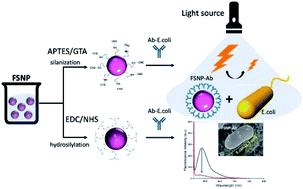Our official English website, www.x-mol.net, welcomes your feedback! (Note: you will need to create a separate account there.)
Optimized antibody immobilization on natural silica-based nanostructures for the selective detection of E. coli
RSC Advances ( IF 3.9 ) Pub Date : 2022-08-03 , DOI: 10.1039/d2ra03143d Diaz Ayu Widyasari 1, 2 , Anis Kristiani 1 , Ahmad Randy 3 , Robeth V Manurung 4, 5 , Rizna Triana Dewi 3 , Agustina Sus Andreani 1, 4 , Brian Yuliarto 2, 4 , S N Aisyiyah Jenie 1, 4
RSC Advances ( IF 3.9 ) Pub Date : 2022-08-03 , DOI: 10.1039/d2ra03143d Diaz Ayu Widyasari 1, 2 , Anis Kristiani 1 , Ahmad Randy 3 , Robeth V Manurung 4, 5 , Rizna Triana Dewi 3 , Agustina Sus Andreani 1, 4 , Brian Yuliarto 2, 4 , S N Aisyiyah Jenie 1, 4
Affiliation

|
This study reports for the first time the surface modification of fluorescent nanoparticles derived from geothermal silica precipitate with Escherichia coli (E. coli) antibody. The immobilization of biomolecules on the inorganic surface has been carried out using two different pathways, namely the silanization and hydrosilylation reactions. The former applied (3-aminopropyl)triethoxysilane (APTES) as the crosslinker, while the latter used N-hydroxysuccinimide coupled with N-ethyl-N′-(3-dimethyl aminopropyl) carbodiimide hydrochloride (EDC/NHS). Fourier transform infrared (FTIR) spectroscopy, field emission scanning electron microscopy with energy dispersive X-ray spectroscopy (FESEM-EDX), and fluorescence spectroscopy were used to confirm the chemical, physical, and optical properties of the surface-modified fluorescent silica nanoparticles (FSNPs). Based on the results of the FTIR, fluorescence spectroscopy and stability tests, the modified FSNPs with EDC/NHS with a ratio of 4 : 1 were proven to provide the optimum results for further conjugation with antibodies, affording the FSNP-Ab2 sample. The FSNP-Ab2 sample was further tested as a nanoplatform for the fluorescence-quenching detection of E. coli, which provided a linear range of 102 to 107 CFU mL−1 for E. coli with a limit of detection (LoD) of 1.6 × 102 CFU mL−1. The selectivity of the biosensor was observed to be excellent for E. coli compared to that for P. aeruginosa and S. typhimurium, with reductions in the maximum fluorescence intensity at 588 nm of 89.22%, 26.23%, and 54.06%, respectively. The inorganic nanostructure–biomolecule conjugation with optimized coupling agents showed promising analytical performance as a selective nanoplatform for detecting E. coli bacteria.
中文翻译:

优化的抗体固定在天然二氧化硅基纳米结构上,用于选择性检测大肠杆菌
该研究首次报道了用大肠杆菌(E.coli)抗体对源自地热二氧化硅沉淀的荧光纳米颗粒进行表面修饰。已经使用两种不同的途径将生物分子固定在无机表面上,即硅烷化和氢化硅烷化反应。前者使用(3-氨基丙基)三乙氧基硅烷(APTES)作为交联剂,而后者使用N-羟基琥珀酰亚胺偶联N-乙基-N'-(3-二甲基氨基丙基)碳二亚胺盐酸盐(EDC/NHS)。傅里叶变换红外 (FTIR) 光谱、场发射扫描电子显微镜与能量色散 X 射线光谱 (FESEM-EDX) 和荧光光谱用于确认表面改性的荧光二氧化硅纳米粒子的化学、物理和光学性质。 FSNP)。基于 FTIR、荧光光谱和稳定性测试的结果,证明了具有 4:1 比例的 EDC/NHS 的修饰 FSNP 为进一步与抗体偶联提供了最佳结果,从而提供了 FSNP-Ab2 样品。FSNP-Ab2 样品作为纳米平台进一步测试用于大肠杆菌的荧光猝灭检测,其线性范围为 10 2至 10 7大肠杆菌的CFU mL -1检测限 (LoD) 为 1.6 × 10 2 CFU mL -1。观察到生物传感器对大肠杆菌的选择性优于对铜绿假单胞菌和鼠伤寒沙门氏菌的选择性,在 588 nm 处的最大荧光强度分别降低了 89.22%、26.23% 和 54.06%。无机纳米结构-生物分子与优化偶联剂的结合显示出作为检测大肠杆菌的选择性纳米平台的良好分析性能。
更新日期:2022-08-03
中文翻译:

优化的抗体固定在天然二氧化硅基纳米结构上,用于选择性检测大肠杆菌
该研究首次报道了用大肠杆菌(E.coli)抗体对源自地热二氧化硅沉淀的荧光纳米颗粒进行表面修饰。已经使用两种不同的途径将生物分子固定在无机表面上,即硅烷化和氢化硅烷化反应。前者使用(3-氨基丙基)三乙氧基硅烷(APTES)作为交联剂,而后者使用N-羟基琥珀酰亚胺偶联N-乙基-N'-(3-二甲基氨基丙基)碳二亚胺盐酸盐(EDC/NHS)。傅里叶变换红外 (FTIR) 光谱、场发射扫描电子显微镜与能量色散 X 射线光谱 (FESEM-EDX) 和荧光光谱用于确认表面改性的荧光二氧化硅纳米粒子的化学、物理和光学性质。 FSNP)。基于 FTIR、荧光光谱和稳定性测试的结果,证明了具有 4:1 比例的 EDC/NHS 的修饰 FSNP 为进一步与抗体偶联提供了最佳结果,从而提供了 FSNP-Ab2 样品。FSNP-Ab2 样品作为纳米平台进一步测试用于大肠杆菌的荧光猝灭检测,其线性范围为 10 2至 10 7大肠杆菌的CFU mL -1检测限 (LoD) 为 1.6 × 10 2 CFU mL -1。观察到生物传感器对大肠杆菌的选择性优于对铜绿假单胞菌和鼠伤寒沙门氏菌的选择性,在 588 nm 处的最大荧光强度分别降低了 89.22%、26.23% 和 54.06%。无机纳米结构-生物分子与优化偶联剂的结合显示出作为检测大肠杆菌的选择性纳米平台的良好分析性能。



























 京公网安备 11010802027423号
京公网安备 11010802027423号